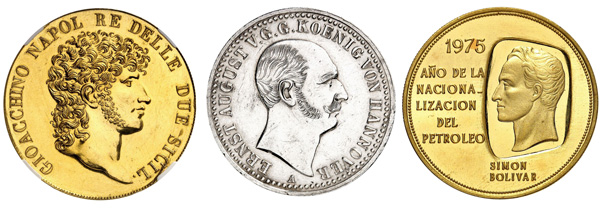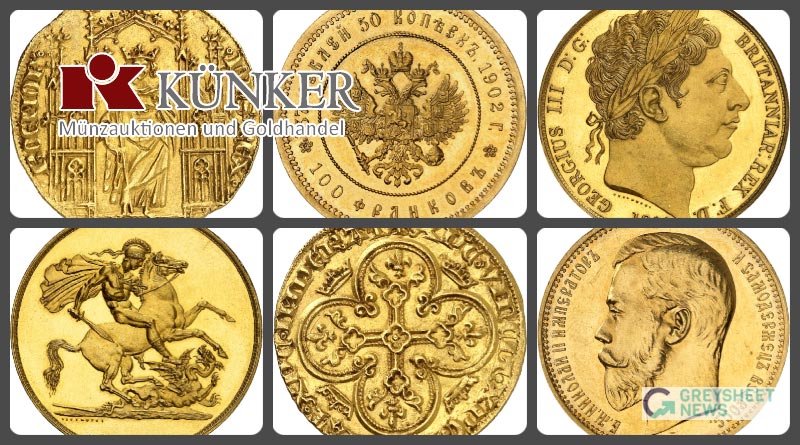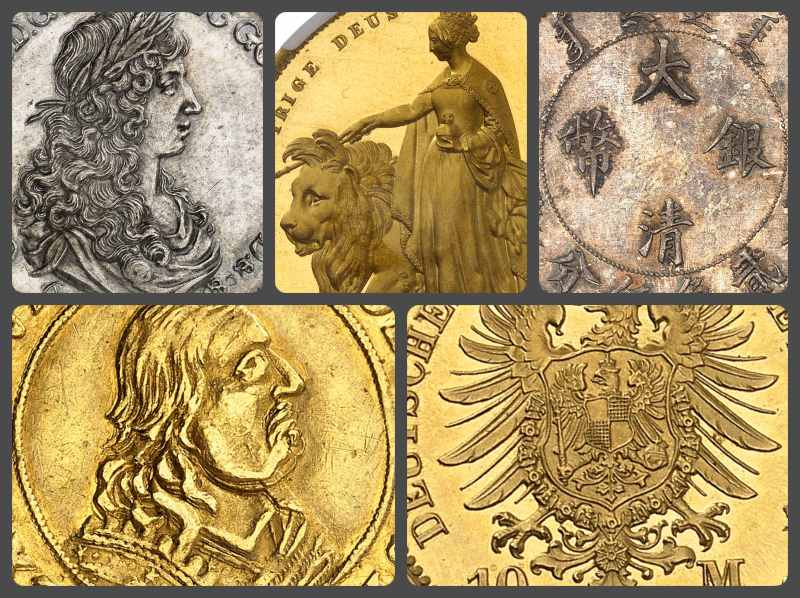Künker’s Summer Auction Sales: A Wealth of Collections
Saxonia in Nummis, the collection of the Berlin savings bank with rarities from Brandenburg-Prussia, gold coins from the Köhlmoos Collection and the Liska Collection with Czechoslovak gold coins – these are just a few of the private collections on offer at Künker’s Summer Auction Sales.
Four catalogs with 3,124 lots and a total estimate of 7.7 million euros – that’s the material of Künker’s Summer Auction Sales, which will be held from 20 to 24 June 2022. Three of the catalogs are dedicated to one impressive collection each. Catalog 368 contains the first part of the Dr. Walter Kemlein Collection with Saxon coins and medals, catalog 369 is dedicated to the collection of the Berlin savings bank including great rarities from Brandenburg-Prussia and rare issues of the German Empire. Catalog 370 deals with German gold and silver coins from the Köhlmoos Collection and catalog 371 combines the material of many private collections, including the Dr. Pavel Liska Collection of Czechoslovak gold coins and a special collection Venezuela.
Catalog 368: Saxonia in Nummis – The Dr. Walter Kemlein Collection
The collection of Saxon coins, medals and decorations built by Dr. Walter Kemlein over about half a century consists of more than 3,500 objects. The first part of this collection marks the beginning of Künker’s Summer Auction Sales 2022 as auction 368. The material covers a time frame ranging from the bracteates of the Margraviates of Wettin and Meißen via the Electorate and Kingdom of Saxony to the Ernestine and Albertine Duchies of Saxony, Saxe-Altenburg, Saxe-Coburg-Eisenach, Saxe-Eisenberg, Saxe-Gotha-Altenburg, Saxe-Coburg-Saalfeld, Saxe-Weimar, Saxe-Weißenfels and Saxe-Zeitz. In addition, there are coins and medals relating to Saxony and Thuringia.
The catalog contains everything a collector of Saxon coins and medals could dream of: bracteates present wonderful Romanesque artworks, rare gold and silver coins feature magnificent Renaissance and Baroque portraits and, not to forget, medals made by the best European artists commemorate historical events that shaped Saxony and had a major impact on Germany as a whole.
There are so many outstanding pieces that it is impossible to list them all in this preview. Particularly remarkable, for example, is a specimen of the first klappmützentaler of very attractive quality with a fine patina and a provenance that can be traced back to 1917. And many collectors will be amazed by the impressive Renaissance portrait of Frederick III, called the Wise. Augustus the Strong is represented by several gold coins of perfect quality and a few extremely rare talers and klippes including the so-called butterfly coins and vicariate issues.
The medals are particularly impressive. These artworks of high historical importance are comparatively affordable considering their rarity. We want to mention two examples for the wealth of material: The reverse of a 1719 silver medal depicts equestrian games organized for the wedding of the son of the prince-elector. Another example is an impressive oval silver medal from 1900, featuring the Jemlich organ of the Church of the Holy Cross in great detail, an instrument that enjoys great renown among music lovers.
The Dr. Walter Kemlein Collection is a mirror of Saxon history and culture, friends of the Free States of Saxony and Thuringia should not miss out on taking a close look at this catalog.
No. 10: Meißen. Conrad the Great of Wettin, 1127-1156. Bracteate. From the Virgil M. Brand Coll., Leu auction 47 (1988), No. 2090. Very rare. Extremely fine. Estimate: 2,500 euros
No. 32: Saxony. Frederick III the Wise, Albert the Bold and John the Steadfast. Taler n.d. (1486-1500), Annaberg or Wittenberg. First klappmützentaler. From the Strupp Coll. Ball auction (1917), No. 872. Very rare. Very fine. Estimate: 20,000 euros
No. 42: Saxony. Frederick III. Broad guldengroschen n.d. (1512), Hall with the title of Maximilian I, commemorating him becoming Governor General. Very rare. Extremely fine. Estimate: 12,500 euros
No. 74: Schmalkaldic League. Joint issue by John Frederick, Elector of Saxony, Maurice, Duke of Saxony, and Philipp, Landgrave of Hesse. Representative coin of 2 talers, commemorating the capture of Henry, Duke of Brunswick, in 1545, Goslar. From Kölner Münzkabinett auction 95 (1995), No. 431. Extremely rare. Very fine to extremely fine. Estimate: 10,000 euros
No. 258: Frederick Augustus I (Augustus the Strong). Double ducat 1702, Dresden, celebrating him receiving the Danish Order of the Elephant. From Peus auction 337 (1993), No. 1600. Extremely rare. About extremely fine. Estimate: 15,000 euros
No. 261: Frederick Augustus I (Augustus the Strong). Butterfly taler n.d. (1708-1710), Dresden. From the Brand Coll., Leu auction 70 (1997), No. 7376. Very rare. Extremely fine. Estimate: 20,000 euros
No. 318: Frederick Augustus I (Augustus the Strong). Silver medal 1719 by O. Wif, commemorating the wedding of the Elector’s son with Maria Josepha of Austria. Extremely rare. Extremely fine. Estimate: 4,000 euros
No. 422: Albert. Gold medal n.d. (1890-1892) by M. Baruleck for excellent artistic achievements. Only 4 specimens minted. Extremely fine to FDC. Estimate: 7,500 euros
No. 433: Dresden. Silver medal 1900 by R. Diller commemorating the re-dedication of the Church of the Holy Cross in Dresden. Extremely rare. Extremely fine. Estimate: 750 euros
No. 447: Saxe-Coburg-Eisenach. John Casimir, 1624-1633. Broad double reichstaler 1627, Saalfeld. From Peus auction 336 (1993), No. 1584. Estimate: 4,000 euros
Catalog 369: The Collection of the Berlin Savings Bank – Brandenburg-Prussia and the German Empire
The coins that have been part of the collection of the Berlin savings bank for many decades and now re-enter the market are downright spectacular. The sale serves a good purpose, as Kai Uwe Peter, Managing Director of the Berlin savings banks association, explains: “Following the motto ‘Art for Culture’, the proceeds will benefit social and cultural institutions in Berlin, to which the Berlin savings bank is deeply committed. They need all the support they can get as the pandemic had particularly devastating effects on Berlin’s culture. Here, too, people can rely on the Berlin savings bank.” In fact, many collectors will be pleased that the important pieces of the bank’s collection will re-enter the market.
The collection of the Berlin savings bank of Brandenburg-Prussian issues consists of two parts. The major part contains – of course – coins from Brandenburg-Prussia, the majority of which are characterized by great rarity and outstanding quality. The focal point is on iconic talers of Prussian history, for example a series of trading coins by Frederick the Great.
Auction house Künker is particularly proud of the fact that this collection contains a coin with which the auction house went down in auction history in 1999, selling the piece in its auction 47 for DM 375,000. Now they are pleased to be able to offer the portugalöser again, which was issued by John George in 1584 in Berlin and had been the most expensive German coin ever sold at auction at the time.
The second part of the collection is dedicated to German coins minted between 1871 and the introduction to the Euro. Here, too, collectors will find numerous rarities, which were selected with a lot of knowledge and refined taste by the curators of the collection. It becomes obvious that only top quality was considered for the coin collection of the Berlin savings bank.
All these magnificent coins are likely to realize outstanding results given the current market situation and benefit those who are in need of urgent help right now. Ulrich Künker comments: “We hope that the funds that will go to Berlin’s art and culture scene can help to mitigate the partly disastrous effects of the pandemic.”
No. 504: Joachim II. Portugalöser of 10 ducats 1570, Berlin. From Hess auction 253 (1983), No. 351 (formerly from the ducal coin cabinet of Gotha). Extremely rare. Traces of mounting, very fine. Estimate: 200,000 euros
No. 505: John George. Portugalöser of 10 ducats 1584, Berlin. From Hess auction 253 (1983), No. 353 (formerly from the ducal coin cabinet of Gotha), and Künker 47 (1999), No. 4001. Unique. Extremely fine. Estimate: 250,000 euros
No. 511: Frederick William, the Great Elector. Reichstaler 1686, Berlin. Very rare. Extremely fine +. Estimate: 15,000 euros
No. 515: Frederick I. Reichstaler 1703, Berlin. Extremely rare. Extremely fine to FDC. Estimate: 20,000 euros
No. 526: Frederick William I, the Soldier King. Reichstaler 1719, Berlin. Extremely rare. Extremely fine. Estimate: 20,000 euros
No. 532: Frederick II the Great. Prussian reichstaler 1752, Berlin. From the Jungfer Coll., Weyl auction 102 (1889), No. 589 (sold for 253 reichsmarks). Only two specimens on the market. Extremely fine. Estimate: 50,000 euros
No. 547: Frederick II the Great. Speciestaler 1755, Berlin, trading coin. Original issue with foliage ornaments. From Schulman auction (Sept. 1920). Extremely rare. Very fine to extremely fine. Estimate: 40,000 euros
No. 646: German Empire. Württemberg. Charles. 5 marks 1888. Extremely rare. Proof. Estimate: 5,000 euros
No. 708: German Empire. Mecklenburg-Schwerin. Frederick Franz IV. 5 marks 1915 A, with inscription embossed on the edge: (ornament) GOTT (ornament) MIT (ornament) UNS (= God with us). Silver. Very rare. Proof. Estimate: 10,000 euros
Catalog 370: German Gold and Silver Coins from the Annemarie and Gerd Köhlmoos Collection
The name “Köhlmoos” has established itself in the numismatic world as a synonym for perfect quality. And catalog 370 containing German gold and silver coins from the Annemarie and Gerd Köhlmoos Collection lives up to this reputation. After auctioning German coins minted from 1800 onwards, it’s now time for the sale of the issues produced by the countless small states of the Holy Roman Empire of the German Nation. Connoisseurs will discover pieces of rulers and cities that only issued very few specimens on highly important occasions. Those interested in the art of portraiture will be fascinated by the skills of German engravers, who impressively captured the features of their patrons – regardless of whether it was in the Renaissance, Baroque or Classicist periods.
The offer is complemented by 43 gold coins of the German Empire, including Reuss, older line, 20 marks 1875 of extremely fine quality and Saxe-Meiningen, 20 marks 1872 of almost FDC quality.
No. 1004: Augsburg / Diocese. Alexander Sigismund of Pfalz-Neuburg. 2 ducats 1708, Augsburg. Extremely rare. Extremely fine to FDC. Estimate: 40,000 euros
No. 1024: Bavaria. Albert V, 1550-1579. Ducat n.d., Munich. Very rare. Extremely fine to FDC. Estimate: 25,000 euros
No. 1063: Prussia. Frederick III (I). Ducat 1706, Minden. Probably the 2nd known specimen. About extremely fine. Estimate: 25,000 euros
No. 1136: Fulda / Abbey. Konstantin von Buttlar. Ducat 1721. Probably 2nd known specimen in private possession. FDC. Estimate: 10,000 euros
No. 1163: Hildesheim / Diocese. Jobst Edmund von Brabeck. Ducat 1694, Hildesheim. Extremely rare. Extremely fine to FDC. Estimate: 20,000 euros
No. 1240: Saxony. Christian I. Ducat 1590, Dresden. Very rare. Extremely fine. Estimate: 20,000 euros
No. 1271: Saxe-Eisenberg. Christian. 2 ducats 1682, Gotha. Extremely rare. Extremely fine to FDC. Estimate: 35,000 euros
No. 1289: Speyer / Diocese. Heinrich Hartard Freiherr von Rollingen. 2 ducats 1711, Augsburg, commemorating him being elected Bishop of Speyer. Extremely rare. Extremely fine to FDC. Estimate: 25,000 euros
No. 1356: Saxe-Meiningen. George II. 20 marks 1872. Very rare. About FDC. Estimate: 20,000 euros
No. 1488: Erfurt / City. Under Swedish occupation. Gustav II Adolf. 1/2 reichstaler 1632. From the Wasserschleben Coll. Probably the only specimen on the market. Very fine. Estimate: 10,000 euros
No. 1529: Hesse-Darmstadt. Ludwig VIII. Konventionstaler 1760, Darmstadt. Extremely rare. Extremely fine. Estimate: 12,500 euros
No. 1592: Montfort. Anton the Younger. 1/2 reichstaler 1695, Langenargen. From the Bachofen von Echt Coll., Hamburger auction 46 (1910), No. 1559. Extremely rare. Extremely fine. Estimate: 10,000 euros
No. 1692: Saxe-Gotha. Ernest II “Taler” (2/3 konventionstaler) 1774, Gotha. Extremely rare. About FDC. Estimate: 12,500 euros
Auction 371: Coins and Medals from Medieval and Modern Times / German Coins after 1871
Auction 371 will be held from 22 to 24 June 2022. It contains world coins and medals made from silver, gold and other materials. Here, too, several private collections will be on sale. We want to present two of them.
Anyone who collects Czechoslovak gold coins should already start saving money for the sale – an abundance of coins of the kind that is offered in this catalogue hasn’t been seen on the market in recent years. More than 100 coins of excellent quality are on sale.
Most of the specimens are from the collection of Dr. Pavel Liska, a Czechoslovak entrepreneur who ran a trading company in Sweden. The premises of his company were located directly across the street from the Ahlström coin shop on Kungsgatan in Stockholm. An avid coin collector, Dr. Pavel Liska initially purchased Swedish issues from Bjarne Ahlström, then he specialized in Czechoslovak gold coins minted after 1923. Like many passionate collectors, Dr. Pavel Liska quickly noticed how rare certain years were. Therefore, he decided to focus his collecting activities on purchasing high-quality specimens of these rarities.
The collector who built the special collection of Venezuelan coinage had a similar ambition. The county gained independence in 1831. The collection dates back to the Spanish dominion and does not only cover issues of the young state but also contemporary Venezuelan coinage and the country’s gold commemorative issues. A 500-bolivares gold coin from 1975 will be of particular importance to all those who are interested in contemporary history. It is dedicated to the nationalization of the oil industry, an event that was to become crucial to the history of modern Venezuela.
These are just two examples of the versatile, exciting material offered by Künker in auction 371. This catalog really has something to offer for every collector. From high-quality multiple gold coins of the Habsburgs to medieval pfennigs, medals, talers and estimates in the lower three-digit range.
The auction ends with an extensive offer of German coins minted after 1871, including many rarities of great quality.
To order a catalog contact Künker, Nobbenburger Straße 4a, 49076 Osnabrück; phone: +49 541 / 962020; fax: +49 541 / 9620222; or via e-mail: service@kuenker.de. You can access the auction catalogs online at www.kuenker.de. If you want to submit your bid from your computer at home, please remember to register for this service in good time.
No. 2105: Naples and Sicily. Joachim Murat, 1808-1815. 5 lire n.d., Naples. Off-metal strike in gold from the original dies, probably around 1950 on behalf of the Egyptian King Farouk. Extremely rare. NGC PF61. Extremely fine to FDC, struck in proof quality. Estimate: 30,000 euros
No. 2129: Poland. Sigismund III, 1587-1632. Portugalöser of 10 ducats n. d., probably Cracow. Extremely rare. Very fine +. Estimate: 75,000 euros
No. 2201: Czechoslovakia. 10 ducats 1934, Kremnica, commemorating the re-opening of the Kremnica mine. Only 68 specimens minted. From the Liska Coll. About FDC. Estimate: 20,000 euros
No. 2215: Czechoslovakia. 5 ducats 1938, Kremnica. Only 56 specimens minted. From the Liska Coll. Extremely fine to FDC. Estimate: 30,000 euros
No. 2404: Mexico. Carlos III. 8 escudos 1768, Mexico City. Very rare. About FDC. Estimate: 25,000 euros
No. 2421: Venezuela. 500 bolivares 1975. Nationalization of the oil industry. Only 100 specimens minted. Proof. Estimate: 10,000 euros
No. 2441: Holy Roman Empire. Ferdinand III. 10 ducats 1648, Brünn. Face value 10 punched on the obverse. Extremely rare. Extremely fine. Estimate: 50,000 euros
No. 2478: Aachen. Gold gulden 1582. Probably the third known specimen. Very fine. Estimate: 20,000 euros
No. 2832: Brunswick and Lüneburg. Ernest Augustus. Taler 1840. Extremely rare. Extremely fine. Estimate: 25,000 euros
No. 2886: Hesse-Kassel. Moritz. Reichstaler 1595, Kassel. Extremely rare. Extremely fine. Estimate: 30,000 euros
No. 2993: Nassau-Dillenburg. Henry. Reichstaler 1683, Herborn. Extremely rare. About extremely fine. Estimate: 20,000 euros
No. 3126: Holstein-Schauenburg. Adolf XIII. Broad 2 1/2 reichstaler 1592. Extremely rare. Extremely fine. Estimate: 30,000 euros
No. 3341: Great Britain. William III. Silver medal 1702 by J. Boskam commemorating his death. Extremely rare. Extremely fine to FDC. Estimate: 15,000 euros
No. 3681: GDR. 20 marks 1982. Zetkin. Motif pattern. Only 90 specimens minted. FDC with original sealing. Estimate: 4,000 euros

Download the Greysheet app for access to pricing, news, events and your subscriptions.
Source: Fritz Rudolf Kuenker GmbH and Co. KG











